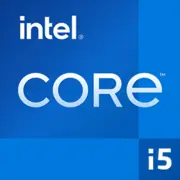Intel Core i5-12400T

Intel Core i5-12400T: The Perfect Choice for Compact and Energy-Efficient Systems
March 2025
The Intel Core i5-12400T processor, released at the end of 2021, remains a relevant solution for users who value a balance between performance and energy efficiency. Despite the emergence of new generations of CPUs, this model continues to be popular due to its low TDP and stable performance in compact systems. Let’s explore who this chip is suitable for and how to properly integrate it into a build.
1. Key Specifications: Hybrid Architecture Without Compromise?
Alder Lake Architecture and Intel 7 Process
The i5-12400T is based on the Alder Lake architecture (2021), which was Intel's first mass-market hybrid design. However, unlike the higher-end models (e.g., i5-12600K), this processor features only 6 Performance-cores (P-cores) without Efficient-cores (E-cores). This simplifies task management but limits multi-threaded performance. The Intel 7 process (10nm Enhanced SuperFin) provides good energy efficiency with a TDP of 35W.
Frequencies and Cache
The base frequency of the P-cores is 1.8 GHz, with a maximum turbo frequency of 4.2 GHz. This frequency range allows for energy savings at idle and rapid acceleration under load. The L3 cache capacity is 18 MB, which enhances responsiveness in applications.
Integrated Graphics
The integrated Intel UHD Graphics 730 is suitable for office tasks, 4K video playback, and less demanding games (such as Minecraft or CS:GO on low settings). For modern AAA games, a discrete graphics card will be necessary.
Performance
- Geekbench 6: 2048 (Single-Core) / 7476 (Multi-Core).
- Compared to the i5-12400 (without the T suffix), the Multi-Core performance is approximately 15% lower due to reduced frequencies, but the energy consumption is nearly half.
2. Compatible Motherboards: LGA 1700 Socket and Chipset Selection
The processor uses the LGA 1700 socket, which supports 600 and 700 series chipsets:
- H610 — Budget option. Suitable for basic builds but limited in PCIe 4.0 slots and USB ports. Example: ASUS Prime H610M-E ($90-110).
- B660/B760 — Optimal choice. Supports DDR4/DDR5, PCIe 4.0, and USB 3.2 Gen2. For example, MSI PRO B760M-A WIFI DDR4 ($130-150).
- H670/Z690/Z790 — Excessive for the i5-12400T, as this chip does not support overclocking. These are only relevant for upgrades with top-tier CPUs.
Important! Some 700-series motherboards (e.g., those with Z790) require a BIOS update to work with Alder Lake. Check compatibility before purchasing.
3. Memory: DDR4 vs. DDR5 — What to Choose?
The processor supports both types of RAM:
- DDR4-3200 — Cheaper but sufficient for most tasks. A 16 GB (2x8) kit will cost about $50-70.
- DDR5-4800 — More expensive (16 GB — $80-100) but offers a 5-10% performance increase in professional applications (rendering, encoding).
Tip: For office PCs and media centers, opt for DDR4. DDR5 is justified only in workstations with demanding software.
4. Power Supply: How Many Watts Are Needed?
With a TDP of 35W, the processor is not demanding on the power supply:
- System without a discrete graphics card: 300-400W is sufficient (e.g., be quiet! Pure Power 11 400W, $60).
- With a graphics card like NVIDIA RTX 3060: Power supplies of 500-600W are recommended (Corsair CX650M, $80).
Important! Even with a low TDP, choose a power supply with an 80+ Bronze certification or higher to ensure stability and at least 85% efficiency.
5. Pros and Cons of the i5-12400T
Pros:
- Energy efficiency: Ideal for mini-PCs and systems with passive cooling.
- Support for PCIe 5.0 and DDR5 (for future-proofing).
- Low price: $150-180 (new, 2025).
Cons:
- No E-cores — multi-threaded performance lags behind Ryzen 5 7600.
- Integrated graphics are weaker compared to AMD Ryzen 5 5600G.
- No overclocking support.
6. Use Cases
- Office Tasks and Web Browsing: Easily handles dozens of tabs and office applications.
- Media Centers: 4K HDR decoding via HDMI 2.0.
- Light Gaming: Combined with a GPU like GTX 1660 Super, it can achieve 60 FPS in Fortnite or Apex Legends.
- Home Servers: Low energy consumption and support for virtualization.
Practical Example: A user built an HTPC with the i5-12400T in a Silverstone ML05 case (4.5L). The system operates silently and consumes 25W at idle.
7. Comparison with Competitors
- AMD Ryzen 5 5600G (2021): Better graphics (Vega 7), but single-core in Geekbench 6 — 1580. Price: $130-160.
- AMD Ryzen 5 7600 (2022): Higher performance (single-core — 2250), but more expensive ($200-220) and requires DDR5.
- Intel Core i5-13400T (2023): 10-15% gain in multi-core, but higher cost ($190-210).
Conclusion: The i5-12400T excels in the budget segment, especially if energy savings are a priority.
8. Assembly Tips
- Cooler: The stock cooler is sufficient, but for complete silence, opt for a Noctua NH-L9i ($50).
- Case: Mini-ITX (e.g., Cooler Master NR200) or compact Micro-ATX.
- Storage: Always use an NVMe SSD (e.g., Samsung 980 500GB, $60).
- Network Capabilities: If the motherboard lacks Wi-Fi, add a PCIe adapter (Intel AX200, $25).
9. Conclusion: Who is the i5-12400T Suitable For?
This processor is an excellent choice for:
- Office PCs — Low power consumption and stability.
- Home Theaters — Quiet operation and 4K support.
- Compact Builds — Minimal heat output.
- Budget Gaming Systems — Paired with a discrete graphics card.
Why choose it? For $150-180, you get modern architecture, support for DDR5/PCIe 5.0, and guaranteed compatibility with Windows 11. If maximum FPS in games or rendering 3D models isn’t required, the i5-12400T is a sound investment for 3-5 years.
Basic
CPU Specifications
Memory Specifications
GPU Specifications
Miscellaneous
Benchmarks
Compared to Other CPU
Share in social media
Or Link To Us
<a href="https://cputronic.com/en/cpu/intel-core-i5-12400t" target="_blank">Intel Core i5-12400T</a>